Biohabitats Projects, Places & People
By Amy Nelson
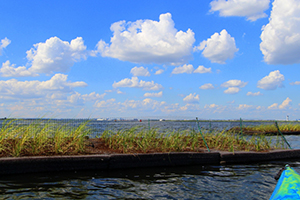
In 2005, recognizing the Bay’s significance and the need to restore and maintain its water quality and ecological integrity, the New York City Department of Environmental Protection (NYCDEP) developed the Jamaica Bay Watershed Protection Plan. In a joint venture with Hazen & Sawyer and HDR, we worked with NYCDEP to implement that plan, which included a number of ecosystem restoration projects.
This summer, our team deployed the final pilot project, a floating island wave attenuator, at Brant Point in Jamaica Bay. Designed by teammates Ocean and Coastal Consultants, and manufactured by Floating Island International and BlueWing Environmental, the floating island attenuators are designed to reduce wave induced erosion while promoting sediment accretion on nearby marshes.
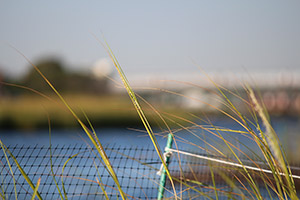
Consisting of buoyant mats planted with Spartina alterniflora and made from a matrix of water filtration material from 100% recycled plastic, the floating island wave attenuators have the potential to also remove pollutants from the water and mimic habitat. Over 2,000 square feet of attenuators were installed and anchored into the Bay in early August, and over the course of the coming months, we will be using Acoustic Doppler Current Profilers (ADCPs) to monitor their effectiveness at reducing the wave energy that causes shoreline erosion. We’ll be sure to keep you posted on this final wave (yuk, yuk) of the Jamaica Bay ecological pilot projects.
Meet the New NORM in Urban Water Treatment & Reuse
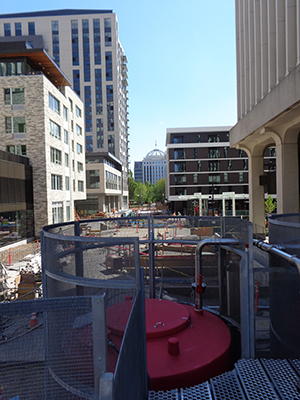
Not long ago, Portland, Oregon locals referred to the city’s Lloyd District as “the land of parking lots.” With the opening of Hassalo on Eighth, a new American Assets Trust development, however, they might just call it “the land of eco-living.” The four-block, sustainable urban development, which is pending LEED Neighborhood Development Platinum certification, boasts the highest level of certification in renewable, clean energy development, a green roof, bike hub, access to mass transportation, and numerous other eco-friendly technologies and amenities. It is also one of the first urban neighborhoods to treat and recycle its wastewater on site through a system known simply as NORM (Natural Organic Recycling Machine). One of the first innovative, district-scale, decentralized, urban wastewater treatment and reuse systems in the U.S., NORM will treat and recycle 100% of all wastewater (grey and black water) from Hassalo on Eighth’s three residential buildings.
Designed by Biohabitats in collaboration with Turner, GBD Architects, PLACE, Glumac, Harper Houf Peterson Righellis, Puttman Infrastructure, Lando and Associates, and Critical Flow, NORM uses natural processes to treat up to 45,000 gallons of wastewater from the 657 apartments of Hassalo’s three residential towers and then recycles it for use in toilet flushing, irrigation, and cooling towers.
If NORM were a person, you’d say he’s thirsty…and thrifty. NORM is projected to deliver savings of seven million gallons of potable water per year and a net savings of $60,000 per year in utility fees. With NORM’s bright red trickling filters and lush, constructed wetland placed prominently at the north end of the development’s main pedestrian plaza, the system is a highly visible reminder of the human connection to water. NORM will be commissioned soon, and you can stay up to date on this exciting project by following NORM on Twitter (@PortlandNORM)!
No Town is Too Small to Benefit from Green Infrastructure
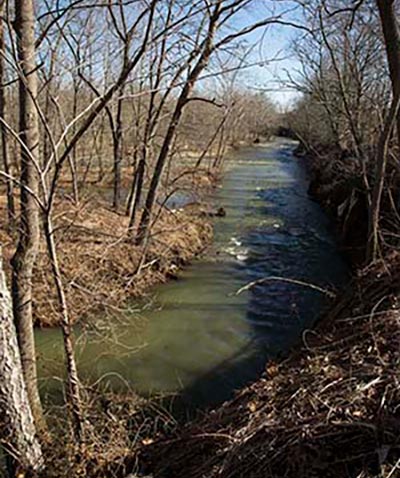
Wardensville, West Virginia may be small (population<300) but its thinking is big. Last year, members of the Wardensville community launched the Wardensville Main Street Initiative, an effort to revitalize the charming town located along the Cacapon River, a tributary to the Potomac River. Included in the Initiative is the goal to protect, restore, and enhance the treasured natural environment and generate citizen stewardship to sustain it. Knowing that green infrastructure delivers a host of benefits—ecological, recreational, educational, and economic, the Initiative partnered with the Town of Wardensville to pursue a NFWF grant to identify opportunities to implement Green Infrastructure. When they sought help with the grant application, we were delighted to be selected as their technical assistance provider. We were happy to receive the news last week that the grant was awarded. The funding will enable our team to prepare preliminary engineering plans for both non-structural stormwater management best management practices and paddle craft access to the Cacapon River and Trout Run. We are eager to get started, and we predict great benefits for this small, forward-thinking town.
Tidal Marsh in a City Canal? You Betcha
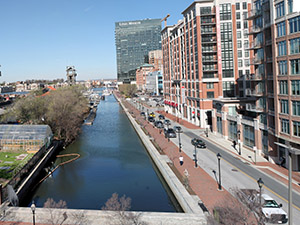
Before the arrival of Europeans in Baltimore in the 1600s, the city’s Inner Harbor was fringed with tidal marsh. Over the course of the city’s development, the Harbor was dredged, tidal wetlands were filled in, and vertical seawalls were installed to support maritime activities. With the loss of the tidal wetlands came the loss of important ecological functions. Tidal wetlands then remained virtually absent from the Harbor until 1990, when the Living Classrooms Foundation restored the last remaining patch on the bank of a canal along Lancaster Street, a popular waterfront walkway.

We are thrilled to be working with the Waterfront Partnership of Baltimore to pick up where that effort left off and continue improving ecological function along the Lancaster Street Canal. We recently presented the Partnership with preliminary concepts that not only included tidal marsh restoration, but a suite of ecological engineering techniques that restore natural system functions by retrofitting the canal’s hardened edges. All of the concepts provide visitors and pedestrians with the unique opportunity to view Chesapeake Bay tidal wetlands and wildlife in an ultra-urban setting. We are now refining concepts to restore tidal wetlands in two sections of the canal, and rafts that will provide sun basking habitat for turtles.
Pond Restoration is Good News for Fish and People
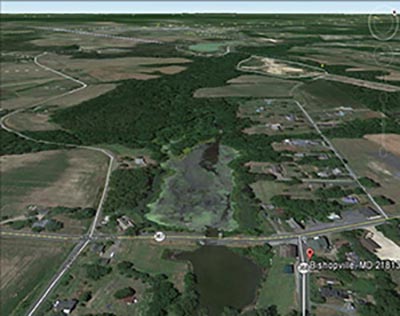
For over a century, a sheet pile dam stood in the Bunting Branch of the St. Martin River, a major tributary to the Isle of Wight Bay in Bishopville, MD. Though the dam blocked passage for migratory fish, it created a four-acre pond which became a key feature for the Bishopville community. Over the decades, however, the pond became severely degraded from chicken agricultural practices, runoff from farmland and development in the watershed.
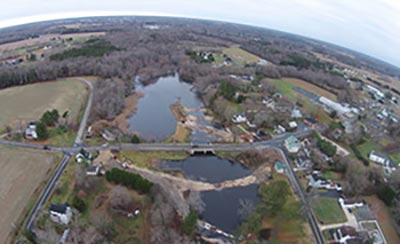
In collaboration with Underwood & Associates, we worked with Maryland’s Department of Natural Resources and Coastal Bays Program, as well as the Maryland State Highway Administration, to design and construct a restoration project that involved converting a portion of the pond to an off-line pond, and restoring fish passage to Bunting Branch. Construction was completed earlier this year and we’re pleased to report that the town now has a much cleaner, more vibrant version of its beloved pond, and migratory fish such as river herring and white perch are now able to access seven miles of upstream habitat for spawning and nursery.
Great Greenway Growing & Getting Greener in Longmont, CO
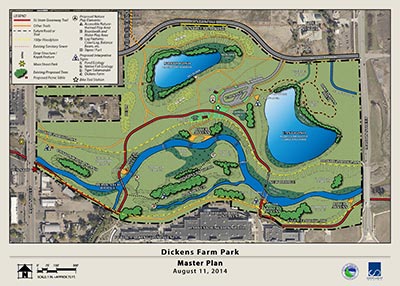 The St. Vrain Greenway, which winds along the St. Vrain Creek in Longmont, Colorado, is part of the Front Range Trail plan, a regional trail system that will someday run from Wyoming to New Mexico. Master planned in 2001, the Greenway is also considered Longmont’s “crown jewel” in a trail system that connects parks, schools, other trails, and commercial areas. As part of a team led by Confluent Design, Biohabitats is now helping the City of Longmont’s Department of Public Works and Natural Resources to further improve the St. Vrain Greenway by transforming a 58-acre former gravel quarry into “Dickens Farm Park.” The new, ecologically robust park will serve as a trailhead for the Greenway and a recreational haven for floaters and paddlers. The flood of September 2013 changed the course of the creek through the property and washed away an eight foot tall water diversion dam. The flood waters also wiped-out aquatic habitat that was home to five native fish species of state concern and two potentially state endangered species. Now that the project is in its design phase, we are working with Colorado Parks & Wildlife staff to design aquatic habitat for the native fish species as well as floodplain wetlands that will provide riparian habitat for a wide range of flora and fauna. We are thrilled to be a part of the design team to ensure that all park elements are ecologically based. Construction is slated for some time in 2016 and we can’t wait to see this new section of an already amazing greenway come to life!
The St. Vrain Greenway, which winds along the St. Vrain Creek in Longmont, Colorado, is part of the Front Range Trail plan, a regional trail system that will someday run from Wyoming to New Mexico. Master planned in 2001, the Greenway is also considered Longmont’s “crown jewel” in a trail system that connects parks, schools, other trails, and commercial areas. As part of a team led by Confluent Design, Biohabitats is now helping the City of Longmont’s Department of Public Works and Natural Resources to further improve the St. Vrain Greenway by transforming a 58-acre former gravel quarry into “Dickens Farm Park.” The new, ecologically robust park will serve as a trailhead for the Greenway and a recreational haven for floaters and paddlers. The flood of September 2013 changed the course of the creek through the property and washed away an eight foot tall water diversion dam. The flood waters also wiped-out aquatic habitat that was home to five native fish species of state concern and two potentially state endangered species. Now that the project is in its design phase, we are working with Colorado Parks & Wildlife staff to design aquatic habitat for the native fish species as well as floodplain wetlands that will provide riparian habitat for a wide range of flora and fauna. We are thrilled to be a part of the design team to ensure that all park elements are ecologically based. Construction is slated for some time in 2016 and we can’t wait to see this new section of an already amazing greenway come to life!
Eco Engineered Technology to Clean Water Proves PORTable
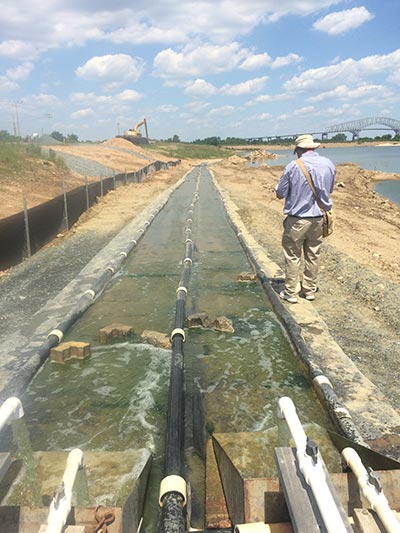 In the last issue of Leaf Litter, we told you about the Maryland Port Administration’s (MPA) use of the Best Urban BMP on the Bay Award (BUBBA) winning Algal Turf Scrubber® (ATS™) eco-technology to reduce the impact of stormwater runoff from the Port of Baltimore’s marine terminals. ATS™ technology harnesses the power of attached filamentous algae to improve water quality.
In the last issue of Leaf Litter, we told you about the Maryland Port Administration’s (MPA) use of the Best Urban BMP on the Bay Award (BUBBA) winning Algal Turf Scrubber® (ATS™) eco-technology to reduce the impact of stormwater runoff from the Port of Baltimore’s marine terminals. ATS™ technology harnesses the power of attached filamentous algae to improve water quality.
After a year of testing a 2 meter by 93 meter ATS™ at its Dundalk Marine Terminal, the MPA is now testing the same unit at Cox Creek, the agency’s 102-acre dredged material containment site. After only one month in operation at Cox Creek’s dewatering area, the ATS™ is proving to be highly productive, yielding 91 grams of dry algae per square meter of ATS™ every day. All that algae takes up nutrients, so if the pilot system was scaled up to one acre that would translate to the removal 137 pounds of nitrogen and 20 pounds of phosphorous from the water with one week’s algae harvest!
Keith Bowers will be giving a keynote address at the Internacional de Restauración EcológicaSymposium in Cali, Colombia this November 12-13, sponsored by the Humboldt Institute and organized by the Red Colombiana de Restauracion Ecologica (REDCRE). Keith will speak on the role of private businesses in delivering ecological restoration projects for public and private sector organizations.
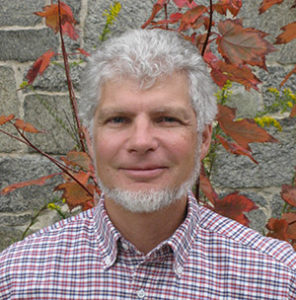
Vince Sortman will be at the AWRA’s Annual Water Resources Conference in Denver, CO November 16-19 to present “Floodplain Restoration along the Cache la Poudre River in Fort Collins, CO.”
Biohabitats senior engineer Pete Muñoz will be in Washington, DC November 18-20 to attend the 2015 Greenbuild International Conference and Expo.
The Maryland Water Monitoring Council will hold its 21st Annual Conference in Linthicum, MD on November 13, and several staff members from our Chesapeake/Delaware Bays Bioregion office will be there!
On December 1-2, Restore America’s Estuaries and the Connecticut Institute for Resilience and Climate Change Adaptation will host a first-of-its-kind living shorelines event! Living Shorelines: Sound Science, Innovative Approaches, Connected Community, will feature nationally-relevant issues and discussions along with region-specific workshops. Biohabitats Hudson River Bioregion leader Terry Doss wouldn’t miss it for the world. Neither should you!
People
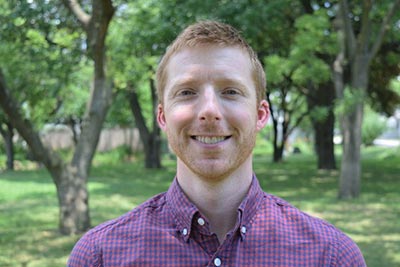 Justin Park’s greatest passion took hold of him at a very early age, when he fell in love with a mouth. The mouth of the Chesapeake Bay, that is. As a boy growing up in Virginia Beach, Virginia, Justin knew that when he grew up, he wanted to do something to protect natural places like his beloved Chesapeake Bay. He just wasn’t sure what. Fortunately for us, he figured it out. After earning his B.S. in Environmental Science from the University of Mary Washington and his M.L.A. from Virginia Tech, Justin began a career as a landscape architect and a journey to find a firm that sought science-based solutions, shared his passion for restoring the natural world, and practiced what it preached. After working with firms in the Washington, DC/Baltimore region on residential, mixed-use, campus, civic, and urban space planning projects, Justin ultimately found Biohabitats, and he couldn’t be happier. Not only has he found a place that embraces his combined knowledge of environmental science and landscape architecture, he gets to apply that knowledge to his first love—the Chesapeake Bay.
Justin Park’s greatest passion took hold of him at a very early age, when he fell in love with a mouth. The mouth of the Chesapeake Bay, that is. As a boy growing up in Virginia Beach, Virginia, Justin knew that when he grew up, he wanted to do something to protect natural places like his beloved Chesapeake Bay. He just wasn’t sure what. Fortunately for us, he figured it out. After earning his B.S. in Environmental Science from the University of Mary Washington and his M.L.A. from Virginia Tech, Justin began a career as a landscape architect and a journey to find a firm that sought science-based solutions, shared his passion for restoring the natural world, and practiced what it preached. After working with firms in the Washington, DC/Baltimore region on residential, mixed-use, campus, civic, and urban space planning projects, Justin ultimately found Biohabitats, and he couldn’t be happier. Not only has he found a place that embraces his combined knowledge of environmental science and landscape architecture, he gets to apply that knowledge to his first love—the Chesapeake Bay.
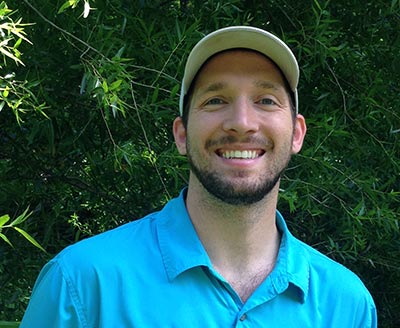 If you ask environmental scientist Greg Zuknick to name his all-time favorite book, he’ll quickly say Hatchett, the young adult wilderness survival novel by Gary Paulsen. In literature and in life, Greg is drawn to wild, natural places. An avid fisherman, crabber, and hunter, Greg also brings his love of the natural world to work. He applies his skills in field work and GIS analysis to ecosystem restoration and green infrastructure design. When he is not working or enjoying nature, Greg can be found brewing his own beer—a survival skill in its own right!
If you ask environmental scientist Greg Zuknick to name his all-time favorite book, he’ll quickly say Hatchett, the young adult wilderness survival novel by Gary Paulsen. In literature and in life, Greg is drawn to wild, natural places. An avid fisherman, crabber, and hunter, Greg also brings his love of the natural world to work. He applies his skills in field work and GIS analysis to ecosystem restoration and green infrastructure design. When he is not working or enjoying nature, Greg can be found brewing his own beer—a survival skill in its own right!
